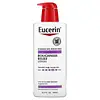What's inside
What's inside
 Key Ingredients
Key Ingredients

 Benefits
Benefits

 Concerns
Concerns

 Ingredients Side-by-side
Ingredients Side-by-side

Water
Skin ConditioningUrea
BufferingGlycerin
HumectantIsopropyl Stearate
EmollientDicaprylyl Ether
EmollientGlyceryl Glucoside
HumectantSodium Lactate
BufferingButyrospermum Parkii Butter
Skin ConditioningNylon-12
Polyglyceryl-4 Diisostearate/Polyhydroxystearate/Sebacate
EmulsifyingCetearyl Alcohol
EmollientArginine Hcl
Skin ConditioningSodium PCA
HumectantLactic Acid
BufferingCarnitine
CleansingMannitol
HumectantSerine
MaskingSucrose
HumectantCitrulline
Skin ConditioningGlycogen
HumectantHistidine Hcl
Skin ConditioningCeramide 3
Skin ConditioningAlanine
MaskingThreonine
Glutamic Acid
HumectantLysine Hcl
Skin ConditioningSodium Chloride
Masking1,2-Hexanediol
Skin ConditioningPhenoxyethanol
PreservativePotassium Sorbate
PreservativeWater, Urea, Glycerin, Isopropyl Stearate, Dicaprylyl Ether, Glyceryl Glucoside, Sodium Lactate, Butyrospermum Parkii Butter, Nylon-12, Polyglyceryl-4 Diisostearate/Polyhydroxystearate/Sebacate, Cetearyl Alcohol, Arginine Hcl, Sodium PCA, Lactic Acid, Carnitine, Mannitol, Serine, Sucrose, Citrulline, Glycogen, Histidine Hcl, Ceramide 3, Alanine, Threonine, Glutamic Acid, Lysine Hcl, Sodium Chloride, 1,2-Hexanediol, Phenoxyethanol, Potassium Sorbate
Water
Skin ConditioningGlycerin
HumectantHydroxyethyl Urea
HumectantDimethicone
EmollientJojoba Esters
EmollientPetrolatum
EmollientCetyl Alcohol
EmollientDistearyldimonium Chloride
Aloe Barbadensis Leaf Juice
Skin ConditioningStearyl Alcohol
EmollientCyclopentasiloxane
EmollientCetearyl Alcohol
EmollientBehentrimonium Methosulfate
Glyceryl Stearate
EmollientMethyl Gluceth-20
HumectantAvena Sativa Kernel Extract
AbrasiveChamomilla Recutita Flower Extract
MaskingBisabolol
MaskingZingiber Officinale Root Extract
MaskingTocopheryl Acetate
AntioxidantDimethicone/Vinyl Dimethicone Crosspolymer
Skin ConditioningMagnesium Ascorbyl Phosphate
AntioxidantPolysorbate 60
EmulsifyingRetinyl Palmitate
Skin ConditioningStearamidopropyl Pg-Dimonium Chloride Phosphate
Butyrospermum Parkii Butter Extract
Skin ConditioningPropylene Glycol
HumectantSteareth-21
CleansingHydrolyzed Jojoba Esters
Skin ConditioningDiazolidinyl Urea
PreservativePanthenol
Skin ConditioningButylene Glycol
HumectantMethylparaben
PreservativeEDTA
Propylparaben
PreservativeBoswellia Serrata Gum
MaskingDipropylene Glycol
HumectantPotassium Hydroxide
BufferingWater, Glycerin, Hydroxyethyl Urea, Dimethicone, Jojoba Esters, Petrolatum, Cetyl Alcohol, Distearyldimonium Chloride, Aloe Barbadensis Leaf Juice, Stearyl Alcohol, Cyclopentasiloxane, Cetearyl Alcohol, Behentrimonium Methosulfate, Glyceryl Stearate, Methyl Gluceth-20, Avena Sativa Kernel Extract, Chamomilla Recutita Flower Extract, Bisabolol, Zingiber Officinale Root Extract, Tocopheryl Acetate, Dimethicone/Vinyl Dimethicone Crosspolymer, Magnesium Ascorbyl Phosphate, Polysorbate 60, Retinyl Palmitate, Stearamidopropyl Pg-Dimonium Chloride Phosphate, Butyrospermum Parkii Butter Extract, Propylene Glycol, Steareth-21, Hydrolyzed Jojoba Esters, Diazolidinyl Urea, Panthenol, Butylene Glycol, Methylparaben, EDTA, Propylparaben, Boswellia Serrata Gum, Dipropylene Glycol, Potassium Hydroxide
 Reviews
Reviews

Ingredients Explained
These ingredients are found in both products.
Ingredients higher up in an ingredient list are typically present in a larger amount.
Cetearyl alcohol is a mixture of two fatty alcohols: cetyl alcohol and stearyl alcohol. It is mainly used as an emulsifier. Emulsifiers help prevent the separation of oils and products. Due to its composition, it can also be used to thicken a product or help create foam.
Cetearyl alcohol is an emollient. Emollients help soothe and hydrate the skin by trapping moisture.
Studies show Cetearyl alcohol is non-toxic and non-irritating. The FDA allows products labeled "alcohol-free" to have fatty alcohols.
This ingredient is usually derived from plant oils such as palm, vegetable, or coconut oils. There is debate on whether this ingredient will cause acne.
Due to the fatty acid base, this ingredient may not be Malassezia folliculitis safe.
Learn more about Cetearyl AlcoholGlycerin is already naturally found in your skin. It helps moisturize and protect your skin.
A study from 2016 found glycerin to be more effective as a humectant than AHAs and hyaluronic acid.
As a humectant, it helps the skin stay hydrated by pulling moisture to your skin. The low molecular weight of glycerin allows it to pull moisture into the deeper layers of your skin.
Hydrated skin improves your skin barrier; Your skin barrier helps protect against irritants and bacteria.
Glycerin has also been found to have antimicrobial and antiviral properties. Due to these properties, glycerin is often used in wound and burn treatments.
In cosmetics, glycerin is usually derived from plants such as soybean or palm. However, it can also be sourced from animals, such as tallow or animal fat.
This ingredient is organic, colorless, odorless, and non-toxic.
Glycerin is the name for this ingredient in American English. British English uses Glycerol/Glycerine.
Learn more about GlycerinWater. It's the most common cosmetic ingredient of all. You'll usually see it at the top of ingredient lists, meaning that it makes up the largest part of the product.
So why is it so popular? Water most often acts as a solvent - this means that it helps dissolve other ingredients into the formulation.
You'll also recognize water as that liquid we all need to stay alive. If you see this, drink a glass of water. Stay hydrated!
Learn more about Water